The Army Combat Fitness Test (ACFT), an essential component of the U.S. Army’s fitness evaluation, has introduced rigorous standards including the Hand-Release Push-Up (HRPU) event to assess upper body endurance. This exercise challenges soldiers to perform hand-release push-ups within a two-minute timeframe, requiring a minimum of 10 for passing and aiming for 57 to achieve maximum points.
A significant update was implemented, awarding soldiers who have never taken a record Army Physical Fitness Test (APFT) a minimum passing score of 360 points on the ACFT. The HRPU standards are designed to be gender-neutral and age-resistant, ensuring all soldiers meet necessary operational readiness, reflecting the Army’s commitment to physical excellence and combat preparedness.
What Is the ACFT Hand-Release Push-Up (HRP) Event?
Before we delve into the intricacies of the HRP event, it’s essential to understand the broader context of the ACFT. The ACFT replaced the traditional Army Physical Fitness Test (APFT) to better reflect the physical demands of combat scenarios. The test comprises six events, each designed to assess different aspects of a soldier’s fitness: the 3-repetition Maximum Deadlift, Standing Power Throw, Hand-Release Push-Up, Sprint-Drag-Carry, Leg Tuck, and the 2-mile run [1].
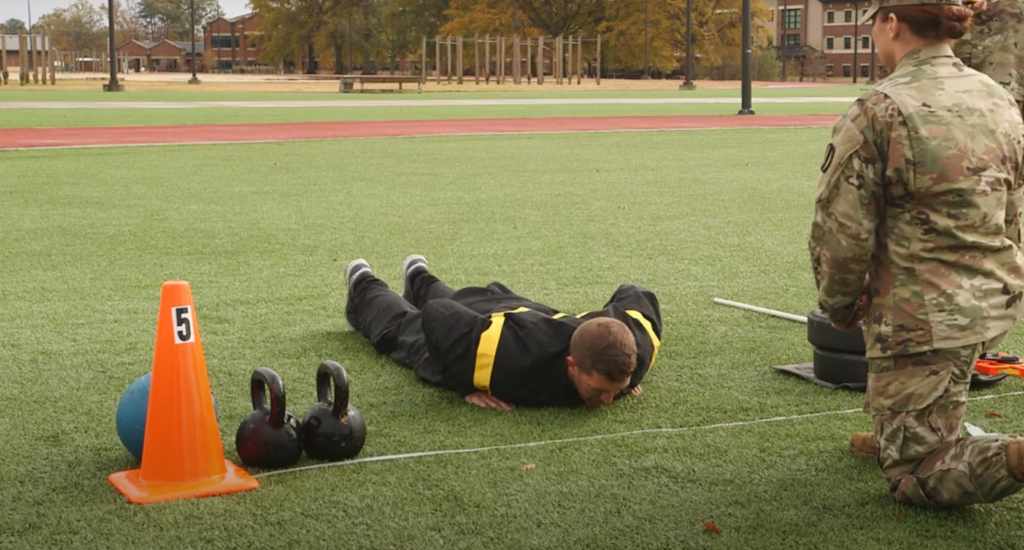
Deconstructing the Hand-Release Push-Up
Purpose and Importance
[tds_note]The Hand-Release Push-Up is a departure from the conventional push-up seen in the APFT. It is designed to evaluate a soldier’s upper body strength, muscular endurance, and the ability to maintain proper form under physical duress. In a real-world scenario, soldiers may need to push themselves off the ground rapidly after taking cover, making the HRP event a practical measure of combat readiness.[/tds_note]
Technique
The Hand-Release Push-Up involves distinct phases that demand precision and control. Here is a step-by-step breakdown of the technique:
Starting Position:
Soldiers begin in the prone position, lying face down on the ground. The hands are placed slightly wider than shoulder-width apart, and the toes are the only part of the body in contact with the ground.
Descent:
Lower the body to the ground by bending the elbows. The chest should make contact with the ground, ensuring a full range of motion [2].
Release Phase:
At the bottom of the push-up, release the hands from the ground by lifting them slightly. This nullifies any potential momentum and necessitates a complete pause, engaging the muscles fully.
Ascent:
Push the body back up to the starting position. The entire body, from head to toe, should move in unison, maintaining a straight line throughout the movement.
Repetition:
Repeat the process for the required number of repetitions. It’s crucial to maintain proper form, as any deviation may result in a failed attempt.
Scoring and Standards
The ACFT HRP event is scored based on the number of repetitions completed within a two-minute timeframe. The scoring standards vary by age and gender, reflecting the Army’s commitment to fairness and inclusivity. Soldiers must strive to meet or exceed the minimum requirements to pass the event, emphasizing the need for consistent training and conditioning. As of 2024, the highest achievable score is 60 repetitions, while the minimum required score stands at 20 repetitions.
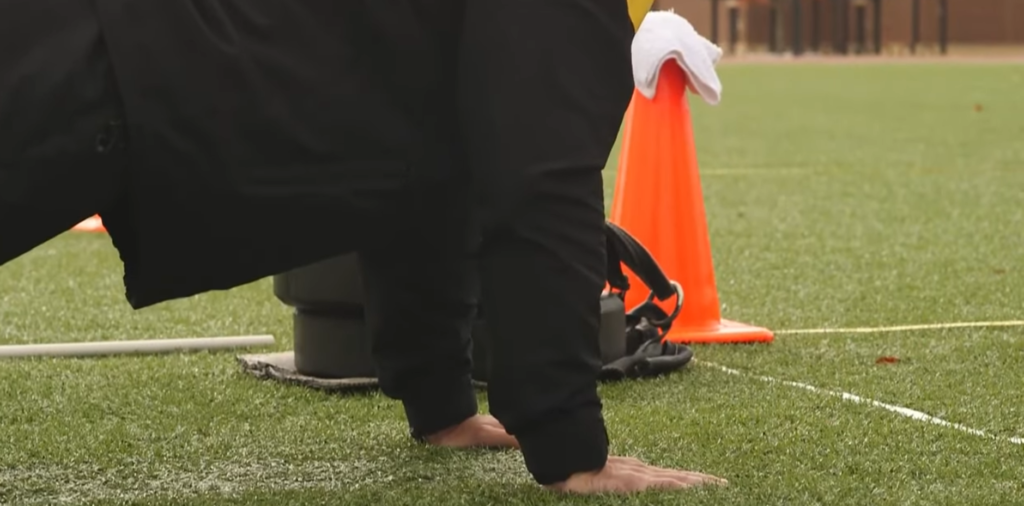
Training for Success
Achieving proficiency in the ACFT Hand-Release Push-Up event requires targeted training. Here are some tips to enhance performance:
Strength Training:
Focus on building upper body strength through exercises like bench presses, tricep dips, and shoulder presses. Strengthening the core is also essential for maintaining stability during the push-up.
Endurance Workouts:
Incorporate high-repetition push-up sets into your training routine to improve muscular endurance. Emphasize proper form over quantity to ensure a solid foundation.
Technique Refinement:
Regularly practice the HRP technique, paying close attention to form and the release phase. This not only enhances muscle memory but also reduces the risk of injury during the event.
Interval Training:
Implement interval training to simulate the time constraints of the ACFT. Work on increasing the number of push-ups performed within two minutes, gradually pushing your limits.
Consistency is Key:
Consistent, progressive training is vital for success in the HRP event. Set realistic goals and track your progress to identify areas for improvement.
Beyond the Numbers: The Psychological Impact
While the physical demands of the ACFT Hand-Release Push-Up are evident, its psychological impact is equally significant. The event challenges soldiers to push past physical and mental barriers, fostering resilience and a warrior mindset. The ability to perform under pressure is a crucial aspect of military readiness, and the HRP event serves as a poignant reflection of this.
Benefits of Hand-Release Push-Ups for Recruits/Soldiers:
1. Functional Strength:
The exercise mimics real-world scenarios where soldiers may need to rapidly push themselves off the ground, enhancing functional strength [3].
2. Enhanced Muscular Endurance:
Hand-Release Push-Ups, especially when performed with speed and control, improve muscular endurance, vital for sustained physical activity in the field.
3. Improved Core Stability:
The full-body engagement required for Hand-Release Push-Ups enhances core stability, contributing to overall physical resilience.
4. Explosive Power:
Speed Push-Ups and explosive variations of Hand-Release Push-Ups build fast-twitch muscle fibers, crucial for quick, powerful movements.
5. Mental Resilience:
Mastering the precision and control demanded by Hand-Release Push-Ups cultivates mental toughness, a valuable asset for recruits and soldiers facing challenging situations.
6. ACFT Performance:
Excelling in Hand-Release Push-Ups contributes significantly to overall success in the ACFT, showcasing a recruit’s or soldier’s physical preparedness.
Incorporating these targeted workouts into your training routine not only hones your Hand-Release Push-Up abilities but also contributes to a well-rounded and functional fitness level, aligning with the demands of military service.
[tds_council]Remember, consistency, proper form, and progressive intensity are key elements in achieving optimal results.[/tds_council]
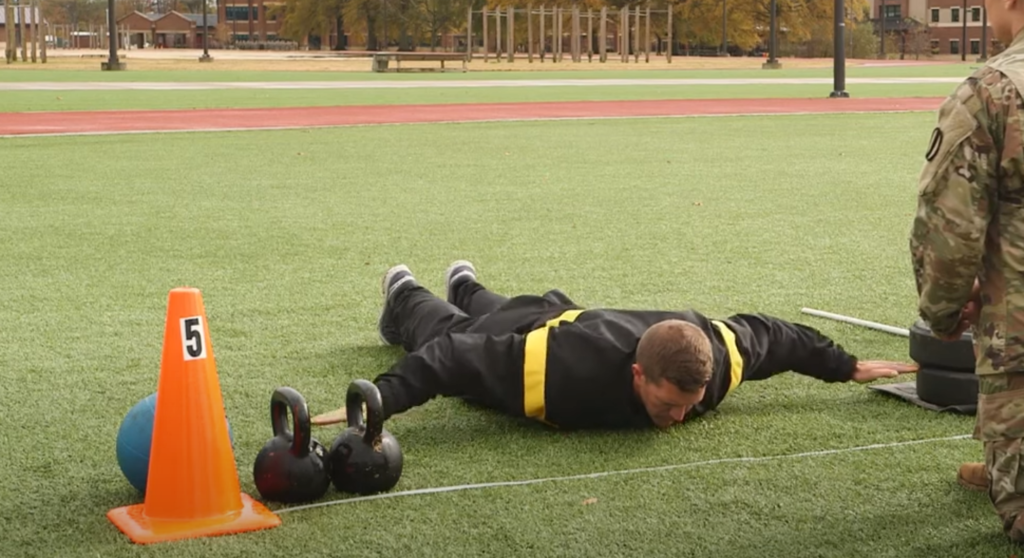
Traditional Push-Up vs. Hand-Release Push-Up
The Traditional Push-Up
1. Basics:
- In a traditional push-up, the starting position involves placing the hands slightly wider than shoulder-width apart;
- The body forms a straight line from head to heels, engaging the core for stability [4];
2. Descent and Ascent:
- During the descent, the elbows bend, lowering the chest towards the ground;
- The entire body moves as one unit, maintaining a continuous motion;
- The chest should hover just above the ground before pushing back up to the starting position;
3. Continuous Movement:
- Traditional push-ups involve a continuous, fluid motion without any pauses;
- The goal is to complete the desired number of repetitions while maintaining proper form;
4. Muscle Engagement:
- Traditional push-ups primarily target the chest, shoulders, triceps, and core;
- The exercise builds strength and endurance across these muscle groups;
The Hand-Release Push-Up (HRP)
1. Starting Position:
- The HRP begins in the same position as the traditional push-up;
- Hands are placed slightly wider than shoulder-width apart, and the body forms a straight line;
2. Release Phase:
- The key differentiator in the HRP is the introduction of a release phase;
- After descending to the ground, the hands momentarily lift off, breaking contact with the floor;
3. Complete Pause:
- During the release phase, there is a complete pause where the chest rests on the ground, and the hands are lifted
- This pause eliminates any momentum and ensures a full range of motion;
4. Ascent:
- The ascent phase involves pushing the body back up to the starting position;
- The entire movement is deliberate, and the hands make contact with the ground before initiating the next repetition [5];
5. Muscular and Mental Challenge:
- The HRP places additional emphasis on the chest, shoulders, and triceps, intensifying the workout compared to traditional push-ups;
- The pause adds a mental challenge, requiring focus and control throughout the exercise;
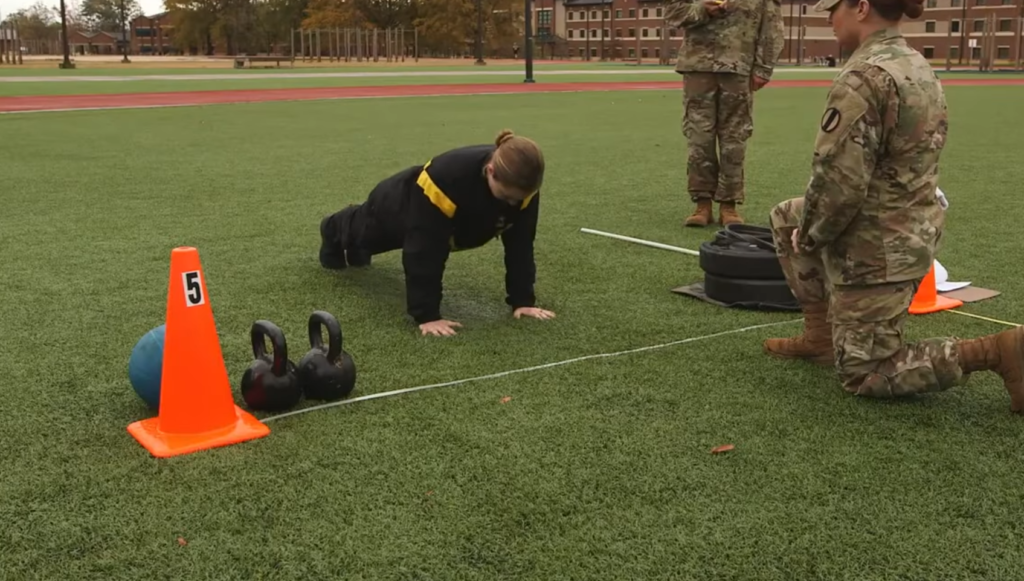
Choosing the Right Fit
1. Strength and Endurance:
- Traditional push-ups are excellent for building foundational strength and endurance;
- Hand-Release Push-Ups, with their added complexity, provide a more challenging workout, targeting muscles in a slightly different way;
2. Training Variety:
- Incorporating both types of push-ups into a training routine offers variety and helps target different muscle groups;
- The traditional push-up is a staple for overall upper body conditioning, while the HRP introduces a unique challenge;
3. Fitness Assessments:
- Understanding the differences between traditional push-ups and HRPs is crucial for individuals preparing for fitness assessments like the ACFT;
- Tailoring training to include specific elements of both exercises ensures a comprehensive approach to physical preparedness;
ACFT Hand Release Push Up Standards (2023):
Here are the ACFT Hand-Release Push-Up (HRP) standards for 2023, as of January 2024:
Male Standards:
- 10-16 (number of reps) – 10 points;
- 17-21 – 20;
- 22-26 – 30;
- 27-31 – 40;
- 32-36 – 50;
- 37-41 – 60;
- 42-46 – 70;
- 47-51 – 80;
- 52-56 – 90;
- 57+ – 100 [6];
Female Standards:
- 10-15 (number of reps) – 10 points;
- 16-20 – 20;
- 21-25 – 30;
- 26-30 – 40;
- 31-35 – 50;
- 36-40 – 60;
- 41-45 – 70;
- 46-50 – 80;
- 51-55 – 90;
- 56+ – 100;
Key Points:
Time Limit: The HRP event is conducted for a maximum of 2 minutes.
Proper Form:
- Strict adherence to proper form is crucial;
- Start in the prone position with hands shoulder-width apart, palms flat on the ground, and fingers pointing forward;
- Lower the body until the chest touches the ground, maintaining a straight back and keeping the elbows at a 90-degree angle;
- Press back up to the starting position, fully extending the elbows;
- Lift the hands completely off the ground and return them to the starting position before starting the next repetition;
Scoring: Only correctly performed repetitions count towards the score.
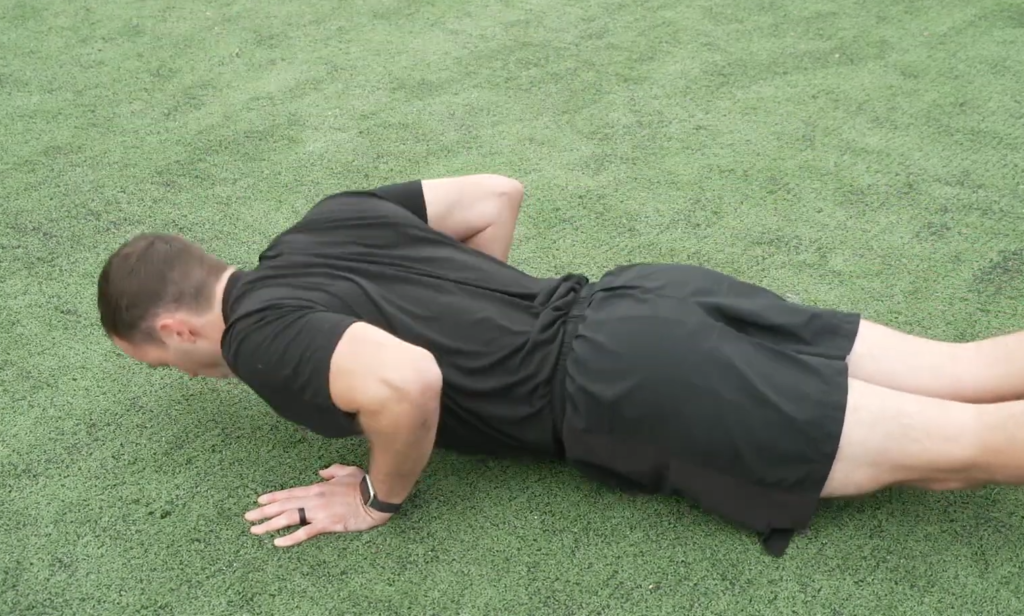
Hand Release Push-Up Instructions And Requirements:
Here are the instructions and requirements for performing hand-release push-ups:
Purpose:
- To assess upper body muscular endurance;
- To develop strength and power in the chest, shoulders, triceps, and core muscles;
- To improve functional fitness for tasks such as carrying heavy loads and climbing obstacles;
Equipment:
- Flat, level surface: A mat or floor is suitable;
- Timer: Optional for tracking performance;
Gloves or No Gloves:
- Choice: It’s a personal preference;
- Benefits of gloves: Protect hands from friction, enhance grip, reduce wrist strain;
- Benefits of no gloves: Better tactile feedback, natural hand position [7];
Proper Attire:
- Comfortable, athletic clothing: Allow for unrestricted movement;
- Supportive footwear: Optional for stability and comfort;
Pre-Test:
- Warm up: Dynamic stretches and light cardio to prepare muscles and joints;
- Practice proper form: Ensure correct technique before starting the test;
Procedure:
Starting Position:
- Prone position: Lie face down on the floor;
- Hand placement: Place hands slightly wider than shoulder-width apart, palms flat on the ground, fingers pointing forward;
- Body alignment: Keep back straight, legs extended, toes tucked under or flat on the ground;
Lowering Phase:
- Controlled descent: Lower your body towards the ground, maintaining a straight back and neutral spine;
- Elbow flexion: Bend elbows to approximately 90 degrees, keeping them close to your sides;
- Chest contact: Lower until your chest touches the ground;

Hand Release:
- Lift hands: Release hands completely off the ground;
- Brief pause: Hold for a moment;
Pushing Phase:
- Return hands: Place hands back on the ground in the starting position;
- Press up: Explosively push your body back up to the starting position, fully extending your elbows;
Return to Starting Position:
- Full extension: Align your body from head to toe in a straight line;
- Maintain tension: Keep core engaged, glutes tight, and legs straight;
Repetition:
Repeat steps: Continue the sequence of lowering, releasing, pushing, and returning to starting position for the desired number of repetitions.
Key Points:
- Strict form: Emphasize proper body alignment and full range of motion throughout the exercise;
- Controlled movement: Avoid bouncing or jerking motions;
- Breathing: Exhale during the pushing phase, inhale during the lowering phase;
- Rest periods: Take brief pauses as needed, but try to minimize rest time;
How Do You Train For ACFT Hand-Release Push-Ups:
1. Supine Chest Press
Purpose:
The Supine Chest Press targets the pectoral muscles, shoulders, and triceps, helping to build the upper body strength essential for mastering the ACFT Hand-Release Push-Up.
Execution:
- Lie on your back on a flat bench with a dumbbell in each hand;
- Start with your arms extended straight up, palms facing forward;
- Lower the dumbbells to the sides of your chest, keeping your elbows at a 90-degree angle;
- Push the dumbbells back up to the starting position, fully extending your arms [8];
Sets and Reps:
Perform 3 sets of 10-12 repetitions, gradually increasing weight as you build strength.
2. 8-Count T-Push-Up
Purpose:
The 8-Count T-Push-Up adds complexity to the traditional push-up, engaging multiple muscle groups and enhancing core stability.
Execution:
- Begin in the push-up position;
- Perform a standard push-up;
- As you ascend, rotate your body, lifting one arm towards the ceiling in a T-position;
- Return to the push-up position and repeat on the other side;
- This exercise integrates both upper body strength and rotational movement;
Sets and Reps:
Start with 2 sets of 8 repetitions, gradually increasing as you improve.
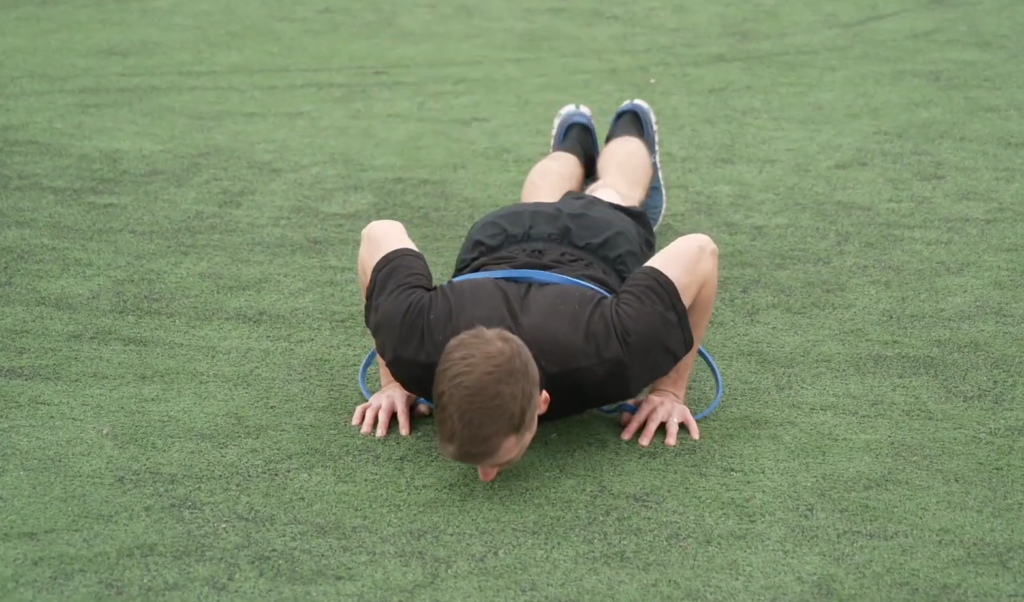
3. Incline Bench
Purpose:
Incorporating an incline bench into your training helps target the upper chest, shoulders, and triceps, simulating the elevated hand position in Hand-Release Push-Ups.
Execution:
- Set an incline bench to a 45-degree angle;
- Sit on the bench and grasp a barbell with hands slightly wider than shoulder-width apart;
- Lower the barbell to your upper chest and push it back up to the starting position;
Sets and Reps:
Perform 3 sets of 8-10 repetitions, gradually increasing the weight as you progress.
4. Quadruplex
Purpose:
The Quadruplex is an advanced exercise that targets the core, chest, and shoulders, enhancing stability and control.
Execution:
- Start in a push-up position;
- Lift one arm and the opposite leg simultaneously, maintaining a straight line from head to heel;
- Return to the starting position and repeat on the other side;
- This exercise challenges your balance and engages multiple muscle groups;
Sets and Reps:
Begin with 2 sets of 6-8 repetitions on each side, focusing on form and control.
Mistakes to Avoid:
1. Injury to the Chest Area
Mistake: Neglecting Proper Form
One of the primary reasons for chest injuries during Hand-Release Push-Ups is neglecting proper form. Failing to maintain a straight line from head to heels or allowing the elbows to flare out excessively can put undue stress on the chest muscles.
Solution:
- Focus on form over quantity. Ensure your body forms a straight line, engaging the core throughout the entire movement;
- Keep the elbows at a 45-degree angle to the body to reduce strain on the chest;
Mistake: Overestimating Strength
Attempting too many repetitions or progressing to advanced variations too quickly can lead to overexertion and potential chest strain.
Solution:
- Gradually progress in difficulty, allowing your muscles to adapt;
- Listen to your body and avoid pushing yourself to the point of fatigue or failure [9];
2. Breathing
Mistake: Holding Your Breath
Many individuals unintentionally hold their breath during the more challenging phases of the Hand-Release Push-Up, limiting oxygen flow to the muscles.
Solution:
- Focus on controlled breathing throughout the exercise;
- Inhale during the descent phase, exhale during the ascent, and maintain a steady breathing rhythm;
Mistake: Shallow Breathing
Inadequate breath control, such as shallow breathing, can compromise oxygen delivery to muscles and hinder overall performance.
Solution:
- Practice diaphragmatic breathing to ensure deep and controlled breaths;
- Concentrate on inhaling through your nose and exhaling through your mouth;
3. Floors and Practice Space
Mistake: Inadequate Floor Surface
Performing Hand-Release Push-Ups on a hard or uneven surface can contribute to discomfort or joint strain.
Solution:
- Choose a comfortable, level surface to practice on. Consider using a mat or carpet to provide some cushioning;
- Ensure there are no obstacles or sharp objects that could cause injury;
Mistake: Insufficient Space
Limited space may compromise your ability to execute Hand-Release Push-Ups with proper form, leading to an increased risk of injury.

Solution:
- Prioritize ample space for your workout to avoid collisions or awkward body positioning;
- If space is limited, modify your hand placement to accommodate the available area;
Trouble Spots On the HRP
1. Incomplete Release Phase
Challenge:
Failing to fully release the hands from the ground during the descent phase compromises the effectiveness of the Hand-Release Push-Up and may lead to scoring discrepancies.
Solution:
- Emphasize a deliberate release by lifting your hands slightly off the ground after lowering your chest;
- Practice slow and controlled Hand-Release Push-Ups to ensure a complete pause in the release phase;
2. Arch in the Lower Back
Challenge:
Allowing the lower back to sag or creating an arch during the movement can lead to poor form and potential discomfort.
Solution:
- Engage your core muscles throughout the exercise to maintain a straight line from head to heels;
- Focus on tightening the glutes and abdominal muscles to prevent the lower back from sagging;
3. Elbows Flaring Out
Challenge:
Allowing the elbows to flare out excessively places undue stress on the shoulder joints and may contribute to discomfort.
Solution:
- Keep the elbows at a 45-degree angle to the body. This position reduces strain on the shoulders and promotes proper muscle engagement;
- Pay attention to elbow placement during each repetition, ensuring they remain close to the torso;
4. Inconsistent Breathing
Challenge:
Neglecting controlled breathing can lead to fatigue and compromise overall performance during Hand-Release Push-Ups.
Solution:
- Establish a rhythmic breathing pattern by inhaling during the descent and exhaling during the ascent;
- Practice diaphragmatic breathing to ensure deep and controlled breaths throughout the exercise;
5. Wrist Discomfort
Challenge:
Putting excessive pressure on the wrists can result in discomfort or pain, hindering your ability to perform Hand-Release Push-Ups comfortably.
Solution:
- Ensure your wrists are aligned with your shoulders and not excessively bent;
- Consider modifying hand placement or using push-up handles to reduce wrist strain;
6. Fatigue and Endurance
Challenge:
Maintaining proper form becomes increasingly challenging as fatigue sets in, potentially leading to compensations and reduced performance.
Solution:
- Prioritize consistent, progressive training to build muscular endurance gradually;
- Incorporate variations such as weighted push-ups or speed push-ups to challenge different aspects of your strength and stamina;
Training Tips:
- Consistency is Key: Regularly incorporate these exercises into your training routine to build strength progressively;
- Proper Form Matters: Focus on maintaining proper form during each repetition to ensure effectiveness and prevent injury;
- Progressive Overload: Gradually increase the intensity by adding weight, increasing repetitions, or adjusting difficulty levels;
- Rest and Recovery: Allow adequate time for muscle recovery between sessions to prevent overtraining;
- Mind-Muscle Connection: Concentrate on the muscles being worked, fostering a strong mind-muscle connection for better results;
FAQ:
1. What is the score for push-ups in the ACFT?
The score for push-ups in the Army Combat Fitness Test (ACFT) depends on the number of hand-release push-ups a soldier completes within the allotted time frame. The scoring is gender-neutral and age-neutral, with performance standards varying by unit type. Soldiers must consult the latest ACFT score chart for specific numbers as it can change periodically.
2. What is the ACFT regulation for 2024?
The ACFT regulation for 2024 may include updates to testing standards, scoring, or the administration of the test. For the most current regulations, soldiers should refer to the latest guidance from the U.S. Army Center for Initial Military Training (CIMT) or contact their unit’s physical training officer.
3. Are hand release push-ups timed?
Yes, hand release push-ups during the ACFT are timed. Soldiers have two minutes to complete as many repetitions as possible.
4. How to do hand release push-ups?
To perform a hand-release push-up, begin in the standard push-up position. Lower your body to the ground, lift your hands off the floor momentarily at the bottom, then push back up to the starting position for one complete repetition.
5. What is a perfect ACFT score?
A perfect ACFT score is 600, which requires exceeding the maximum standard in all six events: the 3-repetition maximum deadlift, standing power throw, hand-release push-up – release, sprint-drag-carry, leg tuck, and the 2-mile run.
6. What are the push-up standards for the APFT?
For the Army Physical Fitness Test (APFT), which the ACFT is replacing, the push-up standards varied by age and gender. The APFT required traditional push-ups, and each soldier had to achieve a minimum number of push-ups to pass. The exact standards were detailed in Army Regulation 350-1.
7. Has anyone scored a 600 on the ACFT?
Scoring 600 on the ACFT is a challenging feat that demonstrates a high level of physical fitness. While individual results are typically not published, there have been anecdotal reports of soldiers achieving a perfect score.
8. What is the max hand release push-up?
The maximum number of hand-release push-ups is not fixed; it is as many as a soldier can complete correctly within the two-minute time limit. Scoring charts define the number needed for the maximum score in this event.
9. Is 400 pushups a day good for you?
Doing 400 pushups a day could lead to overtraining and injury if not balanced with rest and a well-rounded fitness routine. It’s important to listen to your body and progress gradually.
10. How many push-ups is maximum for PFT?
In the Marine Corps Physical Fitness Test (PFT), maximum push-ups vary by age and gender. The maximum score is typically achieved by completing over 70 push-ups within two minutes, but marines should refer to the official PFT standards for specifics.
11. Is the ACFT easy to pass?
Whether the ACFT is easy to pass depends on an individual’s fitness level. The test is designed to be challenging but achievable with proper training and preparation.
12. Are hand release push-ups easier than push-ups?
Hand release push-ups are generally considered more challenging than regular push-ups because they require additional strength and stability to lift the hands off the ground between repetitions.
13. What muscles do hand release push-ups work out?
Hand release push-ups target the chest, triceps, shoulders, and core muscles, with added emphasis on scapular movement and posterior chain engagement.
14. Will 100 pushups a day do anything?
Doing 100 pushups a day can increase muscular endurance and strength over time, but it should be complemented with a balanced workout routine for overall fitness.
15. How many sets of hand release push-ups?
The number of sets for hand release push-ups can vary depending on your fitness goals and level. In training, it’s common to perform multiple sets with rest intervals in between.
16. Why are hand-release push-ups so much harder?
Hand-release push-ups are harder because they involve a full range of motion and require a pause at the bottom to release the hands, which removes the elastic energy typically stored in the muscles during standard push-ups.
17. Can you listen to music during ACFT?
The use of personal electronic devices such as headphones is typically not allowed during official ACFT administration to maintain test standards and safety.
18. What happens if you fail the ACFT?
If a soldier fails the ACFT, they may be provided with additional training and opportunities to retake the test. Consistent failure to meet the standard may lead to administrative actions or discharge from service, according to Army regulations.
Useful Video: Top 5 Tips for ACFT Hand Release Push-Up: HRPU
References:
- https://www.armyprt.com/acft-standards/hand-release-push-up/
- https://www.topendsports.com/testing/tests/push-up-hand-release.htm
- https://www.dummies.com/article/academics-the-arts/study-skills-test-prep/armed-services/acft-event-hand-release-push-up-arm-extension-283771/
- https://armycftcalc.com/hand-release-push-up-army/
- https://usarmybasic.com/hand-release-push-up-hrp/
- https://www.army-fitness.com/acft-events-parent/t-pushup/
- https://www.hprc-online.org/physical-fitness/training-performance/how-train-army-combat-fitness-test
- https://www.gpshumanperformance.com/tactical-training-the-acft-hand-release-push-up-arm-extension/
- https://sfnationalguard.com/6-workouts-to-max-the-army-acft/






Leave a Reply